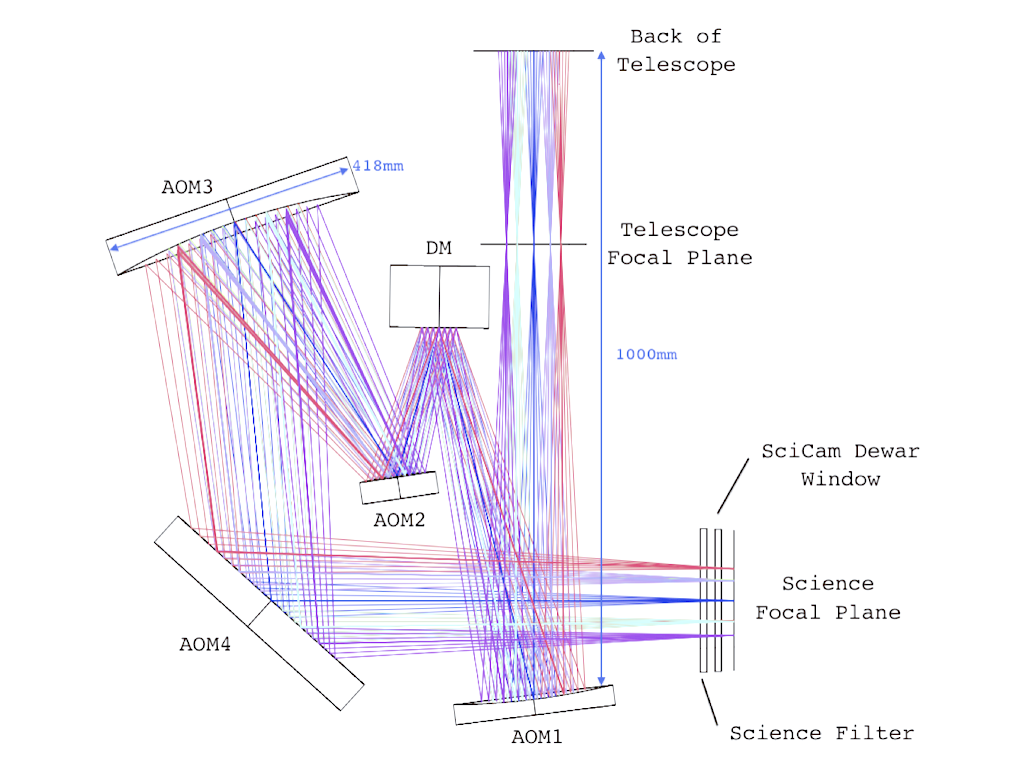Projects
- Details
A2I2 (Astrophysical Applications of Intensity Interferometry)
This project is a collaboration between the quantum optics and cold atoms group of the INstitut de PHYsique de NIce (INPHYNI) and astronomers from the Lagrange laboratory. This is a revival of intensity interferometry originally developed by Hanbury Brown & Twiss in the 1960s, culminating in the Narrabri interferometer. Advances in photonics allows to substantially increase the sensitivity with respect to the experiments of Hanburry Brown & Twiss, and large telescope networks, whether astronomical (e.g. Maunakea, VLTI AT) or Cherenkov, have come online in the past decade and offer ideal platforms for implementation on hectometric or even kilometric baselines.

Temporal correlation with a null baseline (W. Guerin, A. Dussaux, M. Fouché, G. Labeyrie, J.-P. Rivet, D. Vernet, F. Vakili, R. Kaiser, 2017, MNRAS, 472, p.4126-4132.)
Contact:
AIR-FLOW
Airborne Interferometric Recombiner, Fluctuations of light at optical wavelengths, is an instrument for measuring optical turbulence. It is designed to be lightweight, portable and ruggedised to map turbulence in or around telescope domes, to provide a quantitative measure for controlling telescope dome vents and to study effects detrimental to image quality, such as as the Low Wind Effect. The instrument is currently under development and will produce measurements of the phase structure function, to identify the type of turbulence as well as its strength.

Air-Flow project logo.
Contact:
CAOS (Code for Adaptive Optics Systems)
The CAOS Problem Solving Environment (PSE) is an IDL-based suite of numerical tools featuring a graphical programming interface and scientific packages. The scientific packages currently distributed are the eponymic Software Package CAOS (the original adaptive optics systems modelling package) and the Software Package AIRY (an image-reconstruction-oriented package - AIRY stands for Astronomical Image Restoration with interferometrY).
Example of a complete simulation project of a classical AO system by means of the CAOS PSE.
Contact:
CATS
Forthcoming description of the project...
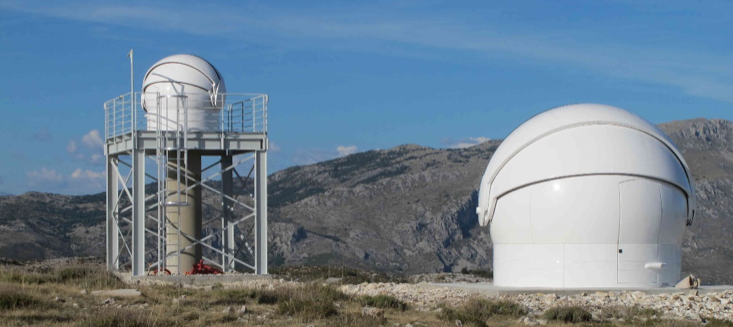
CATS station in Calern.
Contact:
AOC (Adaptive Optics @ Calern)
AOC (previously CIAO) is an adaptive optics (AO) system, including a 10x10 adaptive Shack-Hartmann wavefront sensor (classical stellar AO mode and wide-field planetary mode), and constituting a R&D platform equiping the telescope C2PU-Epsilon. First on-sky technical light was obtained in July 2017. For its stellar mode, AOC will be coupled with HiPIC (visible and near-infrared imaging), while it will be with DSI/JOVIAL (Doppler imaging of the surface of Jupiter) for its planetary mode. The implementation on-sky of the APF-WFS (focal plane sensor, KERNEL project), tests of ultra-stable instrumental concepts, as well as fast control, are also planned.
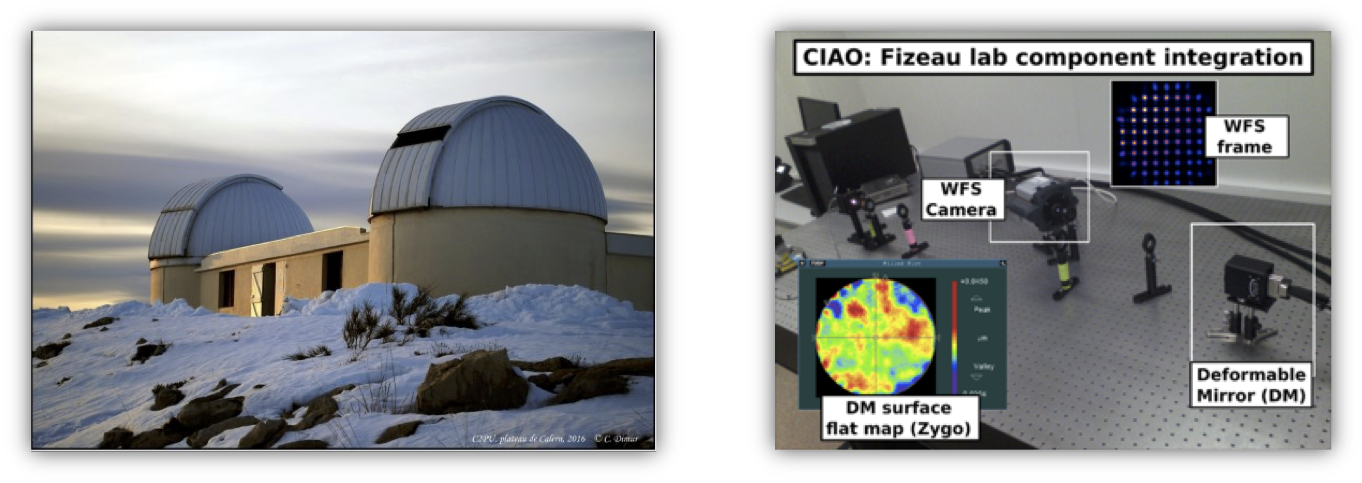
C2PU telescope (left) and laboratory integration of AOC (right).
Contact:
HiPIC (High angular resolution Post-adaptive optics Imaging at Calern observatory)
HiPIC is an visible and near-infrared imaging system (untill band H) permitting to test high-angular resolution imaging techniques under different atmospheric turbulence and adaptive optics (AO) correction regimes, in particular concerning low-correction regimes in terms of Strehl ratio (lower or of the order of 10%). The camera used holds a large wavelengths range, hence a large range of partial AO corrections, extended enough in order to permit the comparison of different techniques : deconvolution of long-exposure images, lucky imaging and advanced speckle techniques on short-exposure images.
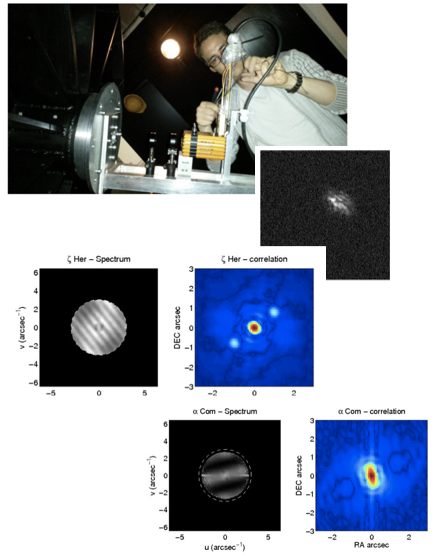
Camera installed at the foyer Cassegrain of telescope C2PU-Epsilon, example of an H-band short-exposure image, without AO correction, then results of the processing with speckle-type techniques for two close binary stars.
Contact:
IMAKA
Imaka is a very wide field adaptive optics demonstrator installed at the University of Hawaii 88" telescope. It consists of 5 Shack Hartmann wavefront sensors with 8x8 sub-pupils in a 24'x20 'field, a bimorph-type deformable mirror with 36 electrodes gracefully on loan from Subaru Telescope and an 11'x11 'scientific field. For commissioning, we use a Finger Lake Instruments camera with 8000x6000 pixel, but eventually the focal plane will accommodate a Hawaii-4RG camera (covering a 7'x7 'field, limited by diffraction in H-band) or a monolithic 10000x10000 pixels STA-10k camera covering an 11'x11 ' field of view.
Forthcoming caption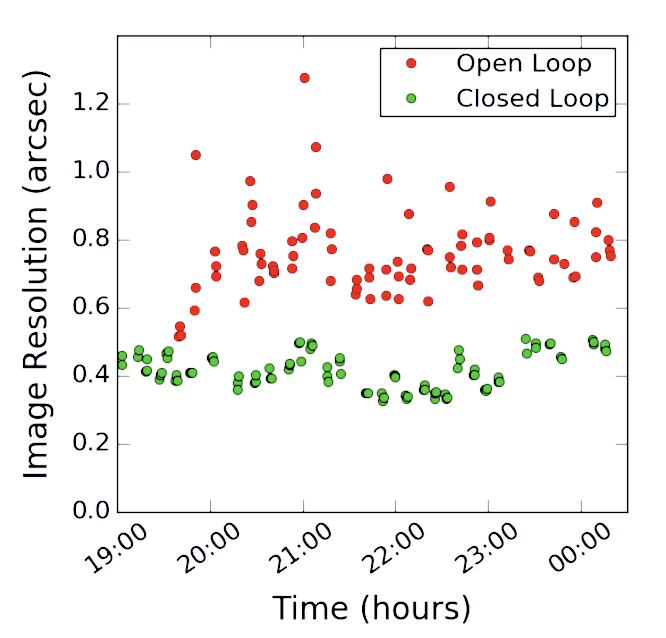 Results at the 2.2m telescope of the University of Hawaii between January and May 2017, (F. Abdurrahman, J. Lu, M. Chun, M. Service, O. Lai, D. Fohring, D. Toomey, C. Baranec, 2018, ApJ, submitted).
Results at the 2.2m telescope of the University of Hawaii between January and May 2017, (F. Abdurrahman, J. Lu, M. Chun, M. Service, O. Lai, D. Fohring, D. Toomey, C. Baranec, 2018, ApJ, submitted).
Contact:
INTENSE/LOTUCE
Forthcoming description of the project...
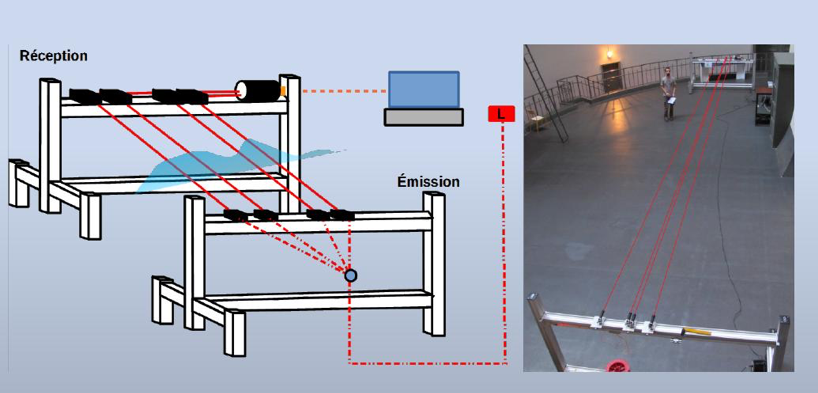
Scheme of principle of the Lotuce/Intense instrument.
Contact:
KERNEL
KERNEL is a project that looks at the formation of images by high angular resolution instruments from an interferometric standpoint and enables super-resolution. This interferometric analysis of simple images benefits two types of applications: (1) the search for observable quantities robust against residual wavefront aberrations called kernels and (2) fine focal-plane based wavefront metrology, particularly suited to low-order modes. KERNEL benefits from technological advances, particularly detectors: the project can develop new use cases, at the frontier between optical interferometry and high-contrast imaging. The KERNEL project is funded by the European Research Council (ERC -CoG # 683029).

The aperture of the JWST is described as that of an interferometer made up of 1500 sub-apertures. This model makes it possible to extract from an image otherwise affected by residual wavefront aberrations, ideal observable quantities called kernels, which can then be directly compared to a parametric model of the target object. The quality of the observables makes it possible to detect contrast sources at very small angular separations (~lambda/D).
Contact:
MATISSE
MATISSE is the spectro-interferometer for the Very Large Telescope of the European Southern Observatory (ESO) located in the Atacama desert of Chile. The instrument operates in thermal IR, and combines up to four beams of the VLT telescopes. MATISSE will push the sensitivity limits to values required by selected astrophysical programs such as the study of Active Galactic Nuclei and protoplanetary discs. Its installation at Paranal took place from October 2017 to February 2018 and successfully ended up with first light on sky. The period of Commissioning is presently going on. The first observation programs have been defined for the period April to September 2019, one of the objective being the validation of the potential of MATISSE to promote its usewithin the international community.
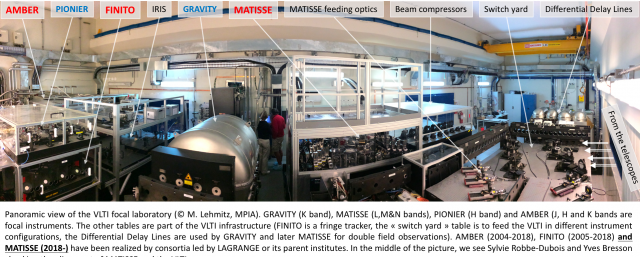
Contact:
- R. Petrov, P. Cruzalebes, S. Robbe-Dubois, S. Lagarde, B. Lopez
SPEED
The SPEED project is an instrumental facility to study high-contrast imaging techniques with a segmented telescope struggled to very close angular separations in view of the next generation of ground- and space-based observatories. The bench combines a segmented telescope simulator with 163 segments, co-phasing optics (in the optical domain), and multi-DM architecture combined with deep coronagraphic imaging (in the near-infrared). The scientific field of view is from 1 to 8 lambda/D in the H-band.
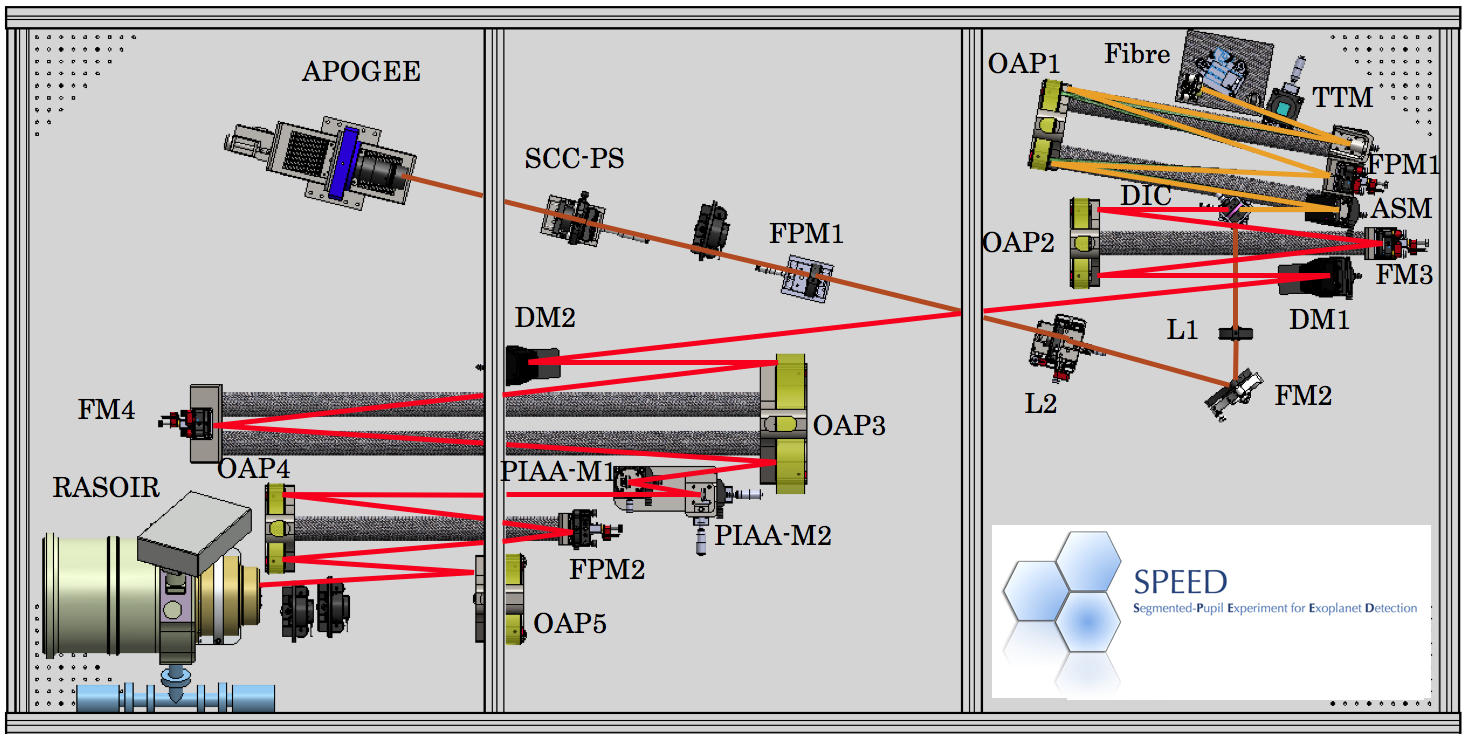
CAO 3D view of SPEED. Color code: telescope simulator (orange), visible range (brown) and near-infrared range (red). Acronyms: TTM - tip/tilt mirror, OAP - off- axis parabola, ASM - active segmented mirror, DM - facesheet deformable mirror), FM - flat mirror, DIC - dichroic, SCC-PS - self-coherent camera-phasing sensor, FPM - focal plan mask, coronagraph (PIAA-M1 & PIAA-M2 - phase inducced amplitude apodization mirror 1 & 2), Lyot stop (LS), APOGEE visible camera, et RASOIR near-infrared camera (RASOIR). Credit: J. Dejonghe.
Contact:
UMR LAGRANGE
Observatoire de la Côte d’Azur
Boulevard de l’Observatoire
CS 34229 - F 06304 NICE Cedex 4
Tél. : +33 (0)4 92 00 30 11
Fax : +33 (0)4 92 00 30 33

